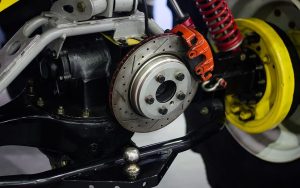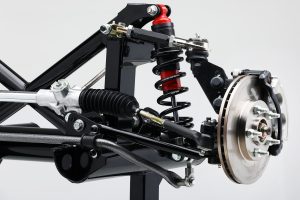Modern cars increasingly rely on smarter suspension systems that adapt in real time to road conditions, vehicle dynamics, and driver preferences. At the heart of many of these systems lie adaptive dampers (sometimes called electronically controlled dampers) and advanced electronic suspension systems. These technologies blur the line between comfort and performance. In this article, we’ll explore the science behind how they work, the trade-offs, control strategies, and practical considerations.
From Passive to Active: The Evolution of Suspension Control

Traditional (passive) suspension systems use fixed springs and dampers (shock absorbers) whose characteristics (spring stiffness, damping coefficients) are tuned at manufacture. These passive systems must strike a compromise: soft enough for comfort, stiff enough for handling. They cannot adjust on the fly.
Electronic or adaptive suspension systems add controllability. Some of these are semi-active (adjusting damping) and others are fully active (adding forces via actuators). Adaptive dampers are a key component of semi-active systems.
The goal is to adjust damping (and sometimes spring behavior) dynamically to suit conditions: rough road, cornering, braking, etc.
How Adaptive Dampers Work: The Core Mechanisms
Adaptive (electronically controlled) dampers are similar in structure to conventional dampers but include additional elements to alter damping stiffness.
Key components and principles:
-
A hydraulic or monotube damper with internal pistons and orifices.
-
An electronically controlled valve (solenoid or motor) that can modulate oil flow or pressure.
-
In some designs, magnetorheological (MR) fluid is used. The damper contains a fluid with suspended ferrous particles whose effective viscosity changes when exposed to a magnetic field. The damper can stiffen or soften almost instantaneously. This is used in systems like MagneRide.
-
Sensors (accelerometers, wheel sensors, yaw/roll sensors) feed data to an ECU (Electronic Control Unit). Based on algorithms and vehicle dynamics, the ECU adjusts the valve or magnetic field to attain desired damping behavior.
Modes and responses:
-
In comfort mode, the damper is softer (valve more open, less resistance) to absorb bumps gently.
-
In sport mode, the damper becomes stiffer, limiting body roll, reducing dive/squat, improving responsiveness.
-
In high dynamic events (cornering, braking), damping behavior is changed rapidly to control chassis motions.
In effect, adaptive dampers allow a suspension to “morph” between comfort and performance behavior.
Types of Electronic Suspension Systems: Semi-Active vs Active
Here’s a breakdown of the major categories:
| System Type | Control Capability | Components Involved | Pros | Cons |
|---|---|---|---|---|
| Semi-Active | Adjust damping only; cannot push or pull (no added energy) | Adaptive dampers + sensors + ECU | Lower complexity, energy efficient, effective damping changes | Cannot add upward forces or fully control displacement |
| Fully Active / Active | Can supply forces (positive or negative) to control body movement | Actuators (hydraulic, electric), control valves, springs, sensors | Ultimate control over body motions (roll, pitch, isolation) | More complex, power consumption, cost and reliability challenges |
Many modern luxury and performance cars use semi-active systems because they offer much of the ride/handling benefit without the complexity and cost of full active systems.
Fully active systems are rarer due to complexity, though research continues in control strategies.
Control Strategies & Algorithms
To adjust damping and suspension forces intelligently, the system needs control logic. Here are some relevant strategies:
Skyhook and Groundhook Ideas
Skyhook control is a theoretical ideal: imagine the vehicle body is connected to a fixed point (a “hook in the sky”) that doesn’t move. The damper tries to minimize body motion relative to that fixed reference. While not physically realizable, many control algorithms approximate it in real time.
Groundhook is similar but references the road surface. Many hybrid controllers (Sky+Ground) try to balance body isolation and road-following.
Adaptive and Model-Based Control
Modern systems use adaptive control, model reference adaptive control (MRAC), or robust control techniques (e.g. H∞) to adjust parameters under varying conditions.
Recent research explores wave-based control (WBC) in active suspension systems to manage vibrations more directly and efficiently.
Semi-Active MR Damper Control
For MR fluid dampers, the controller must determine the current to apply to alter fluid viscosity. Some strategies include fuzzy logic, PID, or derivative-enhanced Skyhook (PD-Skygroundhook) to smooth transitions and avoid abrupt behavior.
A well-designed controller balances comfort (low transmissibility of harshness) and stability (limit roll, pitch, maintain contact).
Benefits and Challenges
Benefits
-
Better ride comfort and isolation from bumps
-
Reduced body roll, pitch, and improved handling
-
Ability to adapt to different driving modes (comfort, sport, off-road)
-
Enhanced stability during cornering, acceleration, braking
-
Improved safety, tire contact, and driver confidence
Challenges & Trade-offs
-
Added complexity and cost
-
Power consumption (especially in active systems)
-
Reliability and durability of electronics and actuators under harsh conditions
-
Tuning difficulty: control algorithms must be robust over broad conditions
-
Integration with other vehicle systems (traction, stability control)
Examples of Systems in Use
-
MagneRide: A notable MR fluid adaptive suspension used by many manufacturers. It changes damping instantaneously by applying a magnetic field to control fluid viscosity.
-
Toyota Electronic Modulated Suspension (TEMS): An early semi-active system that modulated damping force based on sensors and driver modes.
-
Many brands use adaptive damping systems under names like PASM (Porsche), DCC (Volkswagen), AVS (Lexus), etc.
Practical Considerations for Owners and Engineers
If you are considering or working with adaptive or electronic suspension systems, keep these in mind:
-
Sensor calibration and accuracy are critical — a bad sensor can mislead the system.
-
Fail-safe modes: these systems often revert to a default damping setting if a fault is detected.
-
Maintenance: electronics, valves, and actuators require care; they may degrade over time.
-
Integration with powertrain control: adaptive suspension often works in tandem with traction control, ABS, and stability systems.
-
Aftermarket modification: upgrading to adaptive systems in older vehicles is complex and often expensive, requiring custom control modules and tuning.
Future Trends & Research Directions

The research frontier is active. Some areas to watch:
-
Machine learning and AI-based adaptive control, enabling systems to learn and optimize for driver preferences in real time.
-
More efficient actuators (e.g. electromagnetic rather than hydraulic) to lower power consumption.
-
Improved control methods like wave-based control (WBC) or hybrid robust-adaptive controllers.
-
Scaling from single quarter-car models to full-vehicle control with coupling between corners.
-
Integration with predictive systems that read road ahead (via cameras or map data) to pre-adjust suspension.
Summary & Takeaway
Adaptive dampers and electronic suspension systems represent a major leap beyond static suspension designs. By combining sensors, control algorithms, actuators or smart fluids, these systems dynamically adapt to conditions — delivering both comfort and high performance in a single package.
While they bring complexity and cost, their ability to reduce body motion, absorb road irregularities, and improve stability under dynamic loads is transformative. As electronics, actuator technology, and control methods continue to evolve, adaptive suspension may become more common even in mainstream vehicles.
If you’re looking to upgrade or source components for advanced suspension systems, you can Buy Suspension online to access quality parts that support modern adaptive and electronic suspension architectures.